#Twelve Apostles of Ireland
Explore tagged Tumblr posts
Text
#OTD in 587 – St Brendan the Navigator, early transatlantic voyager, dies.
In 484 St. Brendan was born in Ciarraighe Luachra near the port of Tralee, in Co Kerry, in the province of Munster, in the South West of Ireland. He was baptised at Tubrid, near Ardfert, by Saint Erc. He spent his first year with his parents, then he went to the home of the local chieftain, Airde mac Fidaigh at Cathair Airde in Listrim, three miles to the East. He returned to his family at the…
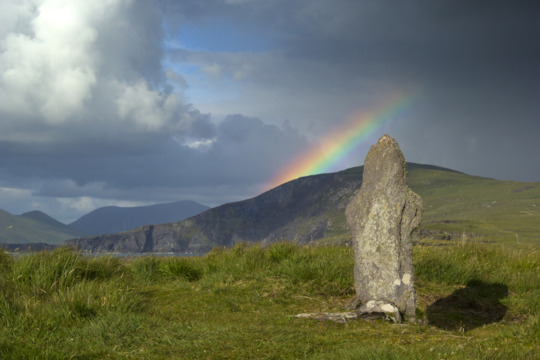
View On WordPress
#Ancient Cross#Ardfert#Co. Kerry#Egressio familiae S. Brendani#Holy Well#Ireland#Mount Brandon#Naval Academy#Navigatio Brendani#Patron Saint of sailors and travellers#St Patrick#St. Brendan the Navigator#Transatlantic Voyager#Twelve Apostles of Ireland#United States Naval Academy#Valentia Island
12 notes
·
View notes
Text
SAINT OF THE DAY (June 9)
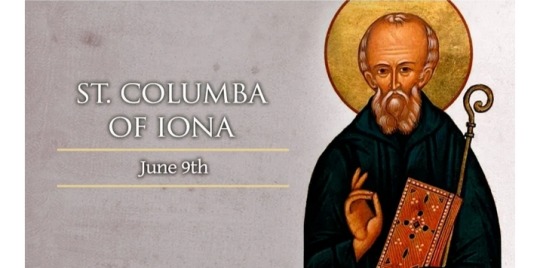
On June 9, the Catholic Church commemorates the sixth-century Irish monk and missionary, Saint Columba of Iona, also known as St. Columcille.
One of Ireland's three patron saints (together with Saint Patrick and Saint Brigid), he is also sometimes called the “Apostle of the Picts” for his evangelization of Scotland.
He should not be confused with St. Columbanus (or Columban), a different Irish monk and missionary who lived slightly later and ended up in Italy.
Columba was born during 521, descended from royalty through his father.
He was taught and mentored by the priest who baptized him. He later attended a monastic school founded by Saint Finnian of Moville.
His own life as a monk began at the school where he was also ordained a deacon.
The deacon went on to spend time in a different monastery and school run by another Finnian, Saint Finnian of Clonard.
Columba became a priest during this period, and along with eleven others from this same institution, he would be known as one of the “Twelve Apostles of Ireland.”
Columba also studied with Saint Mobhi of Glasnevin, before a disease epidemic forced him to return to his ancestral homeland of Ulster during 544.
He spent the next 15 years traveling, preaching, and founding monasteries.
In 563, it is not clear why Columba left Ireland. By some accounts, he was simply going to preach the word of God.
Others claim that he had become involved in a battle between warring tribes, before repenting and taking on foreign missionary work as a penance.
On the island of Iona, located on Scotland’s northwest coast, Columba and his group of companions built simple monastic quarters and a church for themselves.
The priest-monk’s first missionary work was in the region of Dalriada, whose Celtic Christian inhabitants were lacking solid religious instruction.
His next effort was to convert the Picts of northern Scotland, a task that would take up most of the rest of his life.
He began by gaining entrance to the castle of King Brude, where the locked gates are said to have miraculously opened when the sign of the Cross was made.
The king welcomed the missionaries, believed the Gospel, and was baptized.
Columba’s evangelization of northern Scotland continued over the next three decades.
He and his companions met with some resistance from the native pagan Druids, but on the whole, they found remarkable success in spreading the Catholic faith and building up a network of churches and monasteries.
The island monastery at Iona remained his home base. It drew pilgrims looking to benefit from the priest-monk’s wisdom and his prayers.
He remained in touch with the Irish Church, making many trips back until he became too weak to travel.
Even in old age, Columba maintained an intense routine of prayer, fasting, and study.
After giving a final blessing to his monastery on 8 June 597, he died sometime in the early hours of the following day.
#Saint of the Day#Saint Columba of Iona#St. Columcille#Apostle of the Picts#Twelve Apostles of Ireland
4 notes
·
View notes
Text

Saint Ciarán of Clonmacnoise (St. Ciarán or Kieran the Younger) 516 AD - 546 AD Feast Day: September 9th Patronage: Connacht
Saint Ciarán of Clonmacnoise, (sometimes called Ciarán or Kieran the Younger to distinguish him from the 5th-century Saint Ciarán the Elder who was bishop of Osraige), was an Irish saint and abbot whose miracles provided food for many in a time of famine. He was one of the Twelve Apostles of Ireland and the first abbot of Clonmacnoise.
Prints, plaques & holy cards available for purchase here: (website)
46 notes
·
View notes
Text
Today, the Church remembers St. Columba, Abbott of Iona.
Ora pro nobis.
Saint Columba (Irish: Colm Cille, 'church dove'; Scots: Columbkille - 7 December 521 A.D. – 9 June 597 A.D.) was an Irish abbot and missionary credited with spreading Christianity in what is today Scotland at the start of the Hiberno-Scottish mission, which followed the migration of Northeastern Irish colonists to the west coast of Scotland, which had been going on for hundreds of years.
In early Christian Ireland, the druidic tradition collapsed due to the spread of the new Christian faith. The study of Latin learning and Christian theology in monasteries flourished. Columba became a pupil at the monastic school at Clonard Abbey, situated on the River Boyne in modern County Meath. During the sixth century AD, some of the most significant names in the history of Celtic Christianity studied at the Clonard monastery. The average number of scholars under instruction at Clonard was said to be 300. Columba was one of twelve students of St Finnian who became known as the Twelve Apostles of Ireland. He became a monk and eventually was ordained a priest.
In 563, he travelled to Scotland with twelve companions (said to include Odran of Iona) in a wicker currach covered with leather. According to legend he first landed on the Kintyre Peninsula, near Southend. However, being still in sight of his native land, he moved farther north up the west coast of Scotland. The island of Iona was made over to him by his kinsman Conall mac Comgaill King of Dál Riata, who perhaps had invited him to come to Scotland in the first place. However, there is a sense in which he was not leaving his native people, as the Ulster Gaels had been colonising the west coast of Scotland for the previous couple of centuries. Aside from the services he provided guiding the only centre of literacy in the region, his reputation as a holy man led to his role as a diplomat among the tribes.
There are also many stories of miracles which he performed during his work to convert the Picts, the most famous being his encounter with an unidentified animal that some have equated with the Loch Ness Monster in 565. It is said that he banished a ferocious "water beast" to the depths of the River Ness after it had killed a Pict and then tried to attack Columba's disciple named Lugne. He visited the pagan King Bridei, King of Fortriu, at his base in Inverness, winning Bridei's respect, although not his conversion. He subsequently played a major role in the politics of the country. He was also very energetic in his work as a missionary, and, in addition to founding several churches in the Hebrides, he worked to turn his monastery at Iona into a school for missionaries. He was a renowned man of letters, having written several hymns and being credited with having transcribed 300 books. One of the few, if not the only, times he left Scotland was towards the end of his life, when he returned to Ireland to found the monastery at Durrow.
Columba died on Iona and was buried in 597 AD by his monks in the abbey he created. In 794 the Vikings descended on Iona. Columba's relics were finally removed in 849 and divided between Scotland and Ireland. The parts of the relics which went to Ireland are reputed to be buried in Downpatrick, County Down, with Saint Patrick and Brigid of Kildare or at Saul Church neighbouring Downpatrick.
O God, by the preaching of your blessed servant Columba you caused the light of the Gospel to shine in Scotland: Grant, we pray, that, having his life and labors in remembrance, we may show our thankfulness to you by following the example of his zeal and patience; through Jesus Christ our Lord, who lives and reigns with you and the Holy Spirit, one God, forever and ever.
Amen.

4 notes
·
View notes
Text
Saints&Reading: Monday, May 26, 2023
may 26_may
ST. BRENDAN THE VOYAGER, ABBOT OF CLONFERT (577)
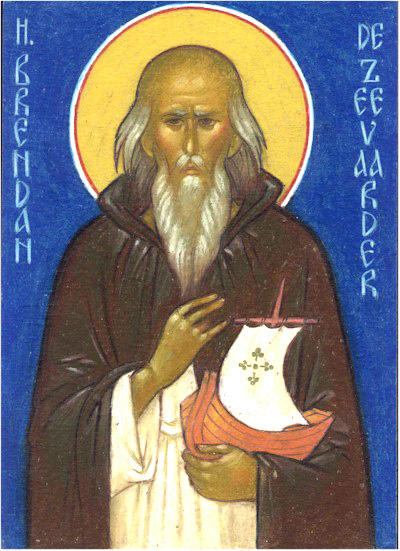
St. Brendan (Brandan, Brandon), called the “Navigator” or also the “Voyager”, is one of the greatest ascetics who lived in Ireland. Unfortunately, his earliest and most reliable hagiographies are lost, and what remains are later twelfth-century Latin and Irish manuscripts, annals, genealogies, traditions, and legends; he is also mentioned in the Lives of some other Irish saints. But, most importantly, he has been loved and venerated by the Irish as one of the nation’s most important Church figures throughout the centuries. According to various traditions, he was born in 484 or 486 and reposed in 575, 577, or 583 at nearly 100. The names of his parents were Finnlug and Cara. The future saint’s birthplace was most probably tiny Fenit Island, situated northwest of the fishing village of Fenit in County Kerry, six miles from the town of Tralee, in the very southwest of Ireland. In the 2000s, a massive statue of St. Brendan was erected on neighboring Great Samphire Island at the entrance to Fenit Harbor to commemorate him.
Fenit, St. Brendan's birthplace, with the harbor and island (taken from Wikipedia)
St. Brendan was baptized as an infant by the holy Bishop Erc of Slane; the night Brendan was born, Bishop Erc saw a great light and a multitude of angels in glowing robes descending from heaven over his parents’ home. Tobar na Molt holy well not far from Tralee and Ardfert, where St. Erc baptized St. Brendan, still exists and is visited by pilgrims seeking physical and mental healing and consolation. There is a chapel near this well with an altar and the figures of three saints (Sts. Brendan, Erc, and Ita). St. Erc may later have ordained St. Brendan as a priest.
Tobar na Molt holy well, in which St. Brendan was baptized, Kerry (photo by Bernard, Geograph.ie)
According to tradition, at the age of two, little Brendan was given by St. Erc to the care of the illustrious holy Abbess Ita († c. 570; feast: January 15) of Killeedy in Limerick, known as “the Foster-mother of the Irish Saints.” Under St. Ita Brendan studied the rudiments of Christianity for five years, and he retained the love and respect for the abbess who nurtured and taught him always. After Killeedy, St. Brendan is believed to have gone to Tuam in Galway, to the famous monastery and school founded by St. Jarlath († c. 540; feast: June 6). Besides, St. Brendan was a disciple of St. Enda of Inishmore (+ c. 530; feast: March 21), one of the earliest monastic founders in Ireland.
Our saint also went to the famous Clonard Monastery in County Meath with the great St. Finnian († 549; feast: December 12), “the Teacher of the Irish Saints”, or one of his successors. Notably, St. Brendan the Navigator (like his saintly namesake, St. Brendan of Birr in Offaly, who reposed in c. 573 and is feasted on November 29) is ranked among “the Twelve Apostles of Ireland,” all of whom were in Clonard. Lastly, tradition says that the young saint traveled to Wales, where he spent some time with St. Gildas (or St. Cadoc) at Llancarfan in Glamorgan, in the monastery famous for its learning. Irish and Welsh monasticism of the age were closely interconnected.
Having been instructed by such celebrated monastic saints, St. Brendan has tonsured a monk, ordained, and then journeyed to the west of his native Ireland to found churches, do extensive missionary work, and shepherd his fellow countrymen. All his biographers wrote that St. Brendan led an austere ascetic life and gained fame as a wonderworker. He excelled in extraordinary zeal for prayer, extreme abstinence, profound humility, and great mercy and love for everyone. In Ireland and Scotland (which he visited many times) St. Brendan established many monasteries. The most famous of them, founded in about 559, was Clonfert, on the west bank of the River Shannon in County Galway. Clonfert, set up by St. Brendan, was renowned all over Ireland. At one time, it is said that it had some 3,000 monks, and future missionaries who later traveled all over Europe to preach the Gospel. One of the most illustrious disciples of Clonfert, who in his youth may have been instructed by St. Brendan, was St. Fursey († c. 648; feast: January 16), who later founded monasteries in Eastern England and France.
Another significant establishment of St. Brendan was the monastery and diocese of Ardfert, which became a large ecclesiastical and monastic center of Kerry close to the saint’s birthplace. Then he established a community at Inis-da-druim, now Coney Island (Innisdadrom) in County Clare. After that he built a monastery at Annaghdown in Galway, by the Bay of Annaghdown near Lough Corrib.
Numerous traditions tell that St. Brendan was also active in the historic Irish province of Leinster, where a host of places are associated with him. Let us mention the parish of Disart in County Kilkenny, Killeney (which still has a church in honor of St. Brendan) and Brandon Hill in Kilkenny. About 1700 feet tall, Brandon Hill, named for St. Brendan, is the highest mountain in County Kilkenny; St. Brendan built a monastic community or church beside it.
Later establishments of St. Brendan worth mentioning are a monastery on the island of Inchiquin, also called Innisquin, in the parish of Killursa in Galway, along with a monastic community on Inishglora off the Mullet Peninsula in County Mayo. For the past 100 years, this island has been uninhabited. Inishglora is noted for its ancient relics related to our saint. Two monastic communities—one for monks and one for nuns—may have existed here simultaneously. Today you can find the ruins of the early St. Brendan’s Church, a “church for men”, and a “church for women” there and drink water from St. Brendan’s holy well, used by local monks in the first millennium! Very ancient cross shafts and other artifacts are situated near the remains of three early beehive cells, one of which belonged to St. Brendan.
Legends associated with Inishglora abound. The historian Gerald of Wales in the late twelfth century testified that as long as monks inhabited this island, human corpses were neither buried nor decayed on it—many bodies were deposited in the open so that people could see their ancestors absolutely uncorrupt for generations (this phenomenon must have ceased when the monks left). The same historian also wrote that vermin, such as mice and rats, never inhabited Inishglora as long as prayer was performed. Though thousands swarmed on other Irish islands, none was found there. Whenever someone brought a rodent to Inishglora, it would instantly run away and leap into the sea or die if it was stopped. Formerly all ships sailing past Inishglora would lower their topsails to pay homage to St. Brendan, whose wonderworking wooden statue stood inside St. Brendan’s Church. Garlic that grows on Inishglora to this day is said to have been planted by monks 1500 years ago!
The more significant part of St. Brendan’s life was spent in travels and voyages (typical for Irish monks and ascetics), which is why he was later nicknamed the “Navigator”. In the eighth and ninth centuries, the famous saga, Navigatio Sancti Brendani (The Voyage of St. Brendan), was composed by an Irish monk, and later other authors wrote more elaborate versions of it. Though famous throughout the Middle Ages, this saga transformed the authentic seafaring ascetic and abbot into a semi-mythical adventurer with supernatural abilities who accomplished unbelievable exploits. According to it, when Brendan was abbot of Clonfert, a monk Barrindus1 once visited him. The monk told him that he had traveled through a thick fog and reached the “heavenly Jerusalem”, full of precious stones, in which the sun never set; there were many mountains, birds sang sweetly, a river flowed from the east to the west, and all the plants were always in bloom. Barrindus had spent a year there...Continue reading orthodoxchristian

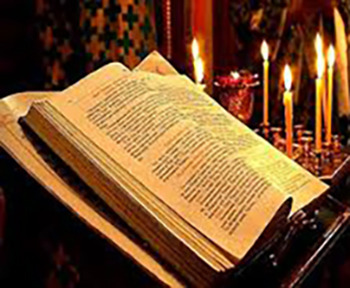
ACTS 21:8-14
8 On the next day we who were Paul's companions departed and came to Caesarea, and entered the house of Philip the evangelist, who was one of the seven, and stayed with him. 9 This man had four virgin daughters who prophesied. 10 And as we stayed many days, a certain prophet named Agabus came down from Judea. 11 When he had come to us, he took Paul's belt, bound his own hands and feet, and said, "Thus says the Holy Spirit, 'So shall the Jews at Jerusalem bind the man who owns this belt, and deliver him into the hands of the Gentiles.' " 12 When we heard these things, we and those from that place pleaded with him not to go up to Jerusalem. 13 Then Paul answered, "What do you mean by weeping and breaking my heart? For I am ready not only to be bound but also to die at Jerusalem for the name of the Lord Jesus." 14 So when he would not be persuaded, we ceased, saying, "The will of the Lord be done."
JOHN 14:27-15:7
27 Peace I leave with you, My peace I give to you; not as the world gives do I give to you. Let not your heart be troubled, neither let it be afraid. 28 You have heard Me say, 'I am going away and coming back to you.' If you loved Me, you would rejoice because I said, 'I am going to the Father,' for My Father is more significant than I. 29 And now I have told you before it comes, that when it does come to pass, you may believe. 30 I will no longer talk much with you, for the ruler of this world is coming, and he has nothing in Me. 31 But that the world may know that I love the Father, and as the Father gave Me commandment, so I do. Arise, let us go from here.
1 I am the true vine, and My Father is the vinedresser. 2 Every branch in Me that does not bear fruit He takes away; and every branch that bears fruit He prunes, that it may bear more fruit. 3 You are already clean because of the word I have spoken to you. 4 Abide in Me, and I in you. As the branch cannot bear fruit of itself unless it abides in the vine, neither can you unless you abide in Me. 5 I am the vine, you are the branches. He who abides in Me bears much fruit, and I in him; without Me, you can do nothing. 6 If anyone does not abide in Me, he is cast out as a branch and is withered; they gather them, throw them into the fire, and are burned. 7 If you abide in Me, and My words abide in you, you will ask what you desire, and it shall be done for you.
#orthodoxy#orthodoxchristianity#easternorthodoxchurch#originofchristianity#spirituality#holyscriptures#gospel#bible#wisdom
2 notes
·
View notes
Text

SAINTS JANUARY 17
Bl. Gregory Khomyshyn, Roman Catholic Priest and Martyr. Arrested for his faith in 1939. Arrested again in April 1945; deported to Kiev, Ukraine. Died in prison. One of the Martyrs Killed Under Communist Regimes in Eastern Europe Feastday January 17
Saint Anthony of Egypt Abbot. St Anthony was born in 251 in Upper Egypt. When he was 20, his parents died, leaving him a large estate. After much prayer Antony decided to sell his possessions and give the money to the poor. His younger sister joined a community of religious women while Anthony went to live in a deserted fort in complete solitude from 286 to 306. During this time he is said to have withstood many temptations. At the end of this time he gathered a group of disciples around him. He visited Alexandria to encourage the Christians there who were being persecuted by Maximinus. In 355 he went to Alexandria to refute the Arians. Jan. 17
St. Mildgytha, 676 A.D. Benedictine nun, daughter of St. Ermenburga, a princess, and Merewald. Her sisters were Sts. Milburga and Mildred. She received the veil from her mother at Minster on the Isle of Thanet and later became abbess of a Northumbrian convent.
Bl. Gonzalo de Amarante, Roman Catholic Dominican Priest. Feastday Jan. 17
St. Nennius. One of the Twelve Apostles of Ireland, he was a disciple of St. Finian. The only other thing known about him is that he was born in Ireland
1 note
·
View note
Text
Ireland’s Historic Treasures: Castles, Cathedrals, and Celtic Sites
Ireland is a country, which is full of history, and is waiting for tourists with ancient castles and cathedrals, mysterious Celtic legends. Regardless of whether you are an architecture freak, a history buff, or an adventurer looking for something off the beaten track, Ireland’s history will amaze you. Ireland offers an extraordinary opportunity to dive into the Middle Ages: beautiful castles rising on the hills, somber cathedrals, and sacred Celticís sites.
If you are interested in visiting the most popular Irish sights, an Ireland tour packageis the best opportunity to start this exciting trip. For visitors who are arriving from India, an Ireland tour package from India is a well-planned vacation where you would get to taste the best of Ireland’s history and scenic beauty without any hassle. Prepare yourself to become a part of Ireland’s history and learn what tales are still happening in the country’s stone.
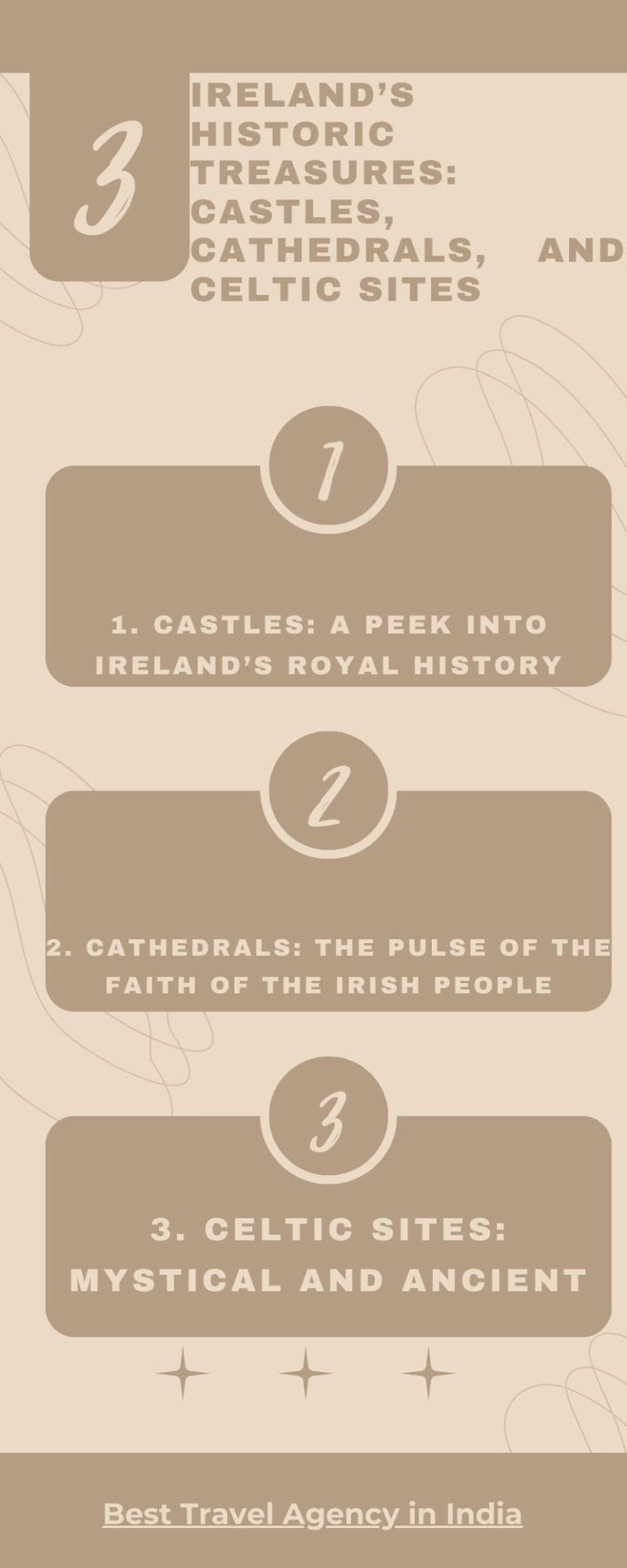
1. Castles: A Peek into Ireland’s Royal History
Ireland has many great castles and a good number of them are as old as they are beautiful. These grand buildings were earlier residences of kings, queens, and the elite early influential families in the formation of the country. No matter if you wandering through the corridors of the historical castle in Blarney, or if you are impressed by the height of the Dublin Castle walls, you are experiencing something from the past.
Blarney Castle is in County Cork, most associated with the Blarney Stone which is popular to make people good speakers if kissed. The other place that one should not miss is Kilkenny Castle, a twelve century tower house with well-maintained gardens.
For those who want something more personal, it would be wise to avail an Ireland tour package since it would then be easy to visit several castles and other important historical sites. It is so much more exciting to be driving through the countryside with a guide who can tell you about these castles.
Check out: South Africa Tour Package | South korea Tour Package | Morocco Tour Package | Ireland Tour Package | Mauritius tour package |Leh and Ladak Tour Package | Jordan Tour package | Oman Tour package | Lakshadweep Tour package
2. Cathedrals: The pulse of the faith of the Irish people
Ireland has some of the beautiful cathedrals in Europe. Apart from being religious structures, these architectural marvels are representations of Ireland’s religious past. St. Dublin’s St. Patrick’s Cathedral, which is devoted to Ireland’s apostle, is one of the most famous sights of the country. Thanks to its towers and Gothic appearance inside, it is possible to get an idea of the religious and cultural role of Christianity in Ireland.
Another rather beautiful church is that of Christ Church Cathedral in Dublin featuring Norman architecture and a beautiful stained glass work. Seeing these cathedrals is an invitation to meditate about Ireland’s past and especially the place that religion has taken in the construction of the country.
Check out: Thailand visa | Dubai visa | Oman visa | Saudi Arabia visa
Bahrain visa | Qatar visa | Kuwait visa | Kazakhstan visa | Argentina visa
Brazil visa | Austria visa
3. Celtic Sites: Mystical and Ancient
Irish history is based on Celtic tradition, and there are numerous Celtic monuments in Ireland that make you more acquainted with the Celtic period. That is why one of the best known Celtic locations in Ireland is the Hill of Tara in County Meath that served as the location of the High Kings of Ireland. Visiting this historical hill provides a good opportunity to get acquainted with the Irish history and have a great view of the country’s countryside.
If antiquity and especially prehistoric monuments are the attractions of choice, Newgrange in County Meath must be visited. This tomb is older even than the Pyramids of Egypt and the stone structure itself is aligned with the winter solstice, proving the Celts’ amazing understanding of astronomy.
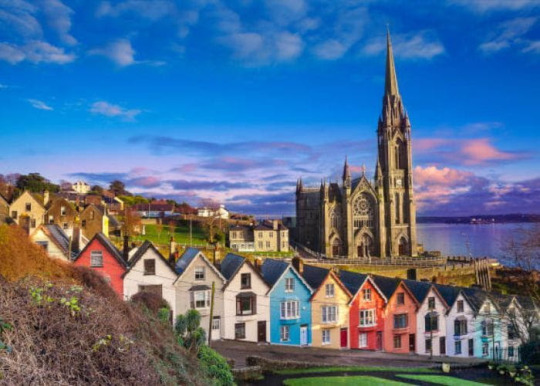
Conclusion:
The history of Ireland, its castles and cathedrals, and Celtic legends are the best chance to plunge into the history of the country and see beautiful landscapes. From the great halls of a castle to the ornate carvings of a cathedral it is impossible to escape the history of Ireland. These historical structures are not only educative inasmuch as they give one a feel of the ancient world, but also spiritual in the sense that they give one a feel of the spirit of this wonderful nation.
Read more: UK Tour Package | Japan Tour Package | Andaman Tour Package | Portugal Tour Package | Russia Tour Package | Seychelles Tour Package | Australia Tour Package
These are some of the historical sites that you will get to see and if you are interested in visiting them an Ireland tour package is the best way to go. For those visiting Ireland from India, getting an Ireland tour package from India means that everything is arranged so that the traveler can easily immerse themselves in the gorgeous and rich history of Ireland. Well, so buckle up and let the tales of Ireland’s history unravel themselves in front of you!
0 notes
Text
Today's Name: ANDREW (IPA: /ˈændruː/)
Usage: English, masculine (very rarely as feminine)
Etymology: English form of Ἀνδρέας (Andreas), derived from ἀνδρεῖος (andreios, meaning "manly, masculine") and ultimately ἀνήρ (aner, meaning "man").
Popularity: Near ubiquitous across European and European-influenced cultures since the medieval period, including a brief spat in the 1980s where it entered the top 1000 most popular girls' names in the USA. Has never been out of the top 1000 in the USA or England and Wales or the top 100 in Canada, but is on the decline (possibly because of the recent infamy of notably terrible people such as Andrew Tate and Prince Andrew, or maybe just because it feels a little old fashioned). It's recently dropped from the top 100 list in Australia, hasn't been in the top 1000 in France for two years, and hasn't been in Aotearoa New Zealand's top 100 since 2013.
Variants: Too many to list entirely, but a shortlist includes nicknames-turned-full-names Andy and Drew (Drew has also become a feminine name in its own right), original Greek form Andreas, European relatives André (France, Portugal, German, Dutch), Andrei/Andrey (Russian and several other related languages), and Anders (Scandinavian). There's also Andrea, largely masculine countries like Italy and Belgium and gender-neutral in France and Switzerland, but considered a feminine name elsewhere.
Famous Namesakes: So many there's a whole Wikipedia page of people named Andrew, but a few notable ones below.
Several saints, most famously Andrew the Apostle, one of Jesus' twelve disciples.
Three medieval kings of Hungary
Two American presidents, Jackson and Johnson, both notably awful people even by the standards of the day (USA)
Andrew Lloyd Webber, composer (England)
Andy Murray, tennis player (Scotland)
Andrew Scott, actor (Ireland)
Andy Warhol, artist (USA)
0 notes
Text
Saint of the Day – 12 December – Saint Columba of Terryglass (Died 552) Abbot, One of the Twelve Apostles of Ireland
Saint of the Day – 12 December – Saint Columba of Terryglass (Died 552) Abbot, Founder of Monasteries, Miracle-worker. One of the Twelve Apostles of Ireland, pupil and disciple of St Finnian of Clonard (470–549) known as the “Tutor of the Saints of Ireland.” Born in Leinster, Ireland and died on 13 December 552 of the Plague at his Monastery in Terryglass, where he was also buried. Also known as…
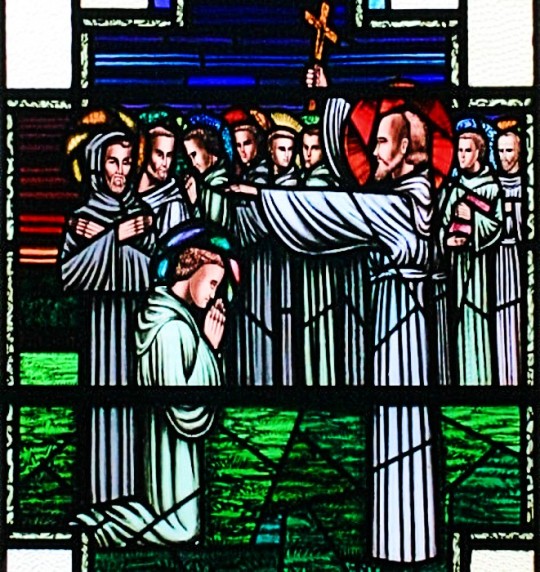
View On WordPress
1 note
·
View note
Text
"The Spread of Christianity in the British Isles: Monastic Missions and Roman Authority Triumphs"
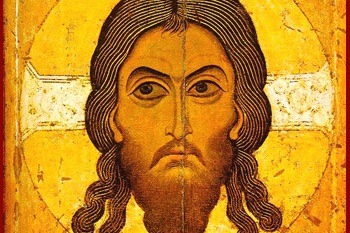
The spread of Arianism among Germanic tribes and the conversion of the Franks to Roman faith were noted. Catholic orthodoxy was gradually accepted by Germanic invaders. However, there was still much to do. The church's vitality during the collapsing empire and opening Middle Ages was shown through its successful extension of Christianity.
Ireland and Scotland
Christianity was present in British Isles before Constantine's conversion. The Roman Empire's downfall weakened it among the Celtic population, while the Anglo-Saxon invaders won much of southern and eastern England for heathenism. Christian beginnings were found mainly in southern Ireland before Patrick. However, he greatly advanced the cause of the Gospel in Ireland and organized its Christian institutions, earning the title of Apostle of Ireland.
Patrick was born in 389 and was the son of a deacon and grandson of a priest. He was trained in Christianity. In 405, he was taken as a slave in Ireland for six years. He was able to escape to the Continent and lived in the monastery of Lérins for some time. In 432, he was ordained a missionary bishop by Bishop Germanus of Auxerre. Patrick then began his work in Ireland, where he spent most of his time in the northeast, with some efforts in the south and west. Despite few facts surviving, there is no doubt about his zeal and his abilities as an organizer. He systematized and advanced Christianity in Ireland. Patrick brought the island into association with the Continent and with Rome.
Patrick introduced the diocesan episcopate into Ireland, but it was soon modified by the island's clan system, resulting in many monastic and tribal bishops. Finian of Clonard (470?-548) developed the unique Irish monasticism, which included strong missionary efforts and notably learned monasteries. The Irish monastic schools were famous in the sixth and seventh centuries, and the monasticism's greatest achievement was its missionary work.
The origins of Christianity in Scotland are unclear. Ninian and Kentigern spread the religion in the 4th and 5th centuries respectively, but not much is known about their work. There is a possibility that the Irish settlers who founded the kingdom of Dalriada in 490 were Christians. However, the most influential missionary was Columba. He founded a successful monastery on the island of Iona and went on to spread the Gospel among the Picts in the northern regions of Scotland. Christianity in Scotland was mainly monastic, with bishops under the authority of Columba and his successors as abbots of Iona.
Missionaries on the Continent
Irish missionaries brought Christianity to northern England, Lindisfarne. Aidan, a monk from lona, established a new Iona on the island in 634. Christianity was then widely spread in the region by Aidan and his associates. These Celtic monks were also active outside of the British Islands. Columbanus, a monk from the Irish monastery of Bangor, founded the monastery of Luxeuil in Burgundy. He later established the monastery of Bobbio in northern Italy, where he died a year later.
Columbanus was one of many Irish monks who worked in central and southern Germany. They introduced private confession to the laity, which was widely supported by the Irish monks. The Irish also created the first penitential books with appropriate satisfactions for specific sins. These books were made familiar on the Continent by the Irish monks.
Roman Missionaries in England
Pope Gregory the Great sent Augustine, a Roman friend, and several monastic companions to convert the Anglo-Saxons. After much struggle, Æthelberht and many of his followers accepted Christianity. Augustine was then appointed as a metropolitan bishop and was authorized to establish twelve bishops under his jurisdiction. It took almost a century for Christianity to become dominant in England, but the movement strengthened the papacy and produced some of the most energetic missionaries on the Continent.
The acceptance of Christianity in England was not without difficulty. After the death of Ethelberht, the power of Kent declined, and with it the initial Christian successes. Northumbria gradually emerged as the leader. In 627, King Edwin of Northumbria was converted to Christianity through the efforts of Paulinus, who later became bishop of York. However, in 633, the heathen King Penda of Mercia defeated and killed Edwin, leading to a heathen backlash in Northumbria.
Under the Christian King Oswald, who had converted while in exile in Iona, Christianity was re-established in Northumbria with the help of Aidan, who represented the Irish or "Old British" tradition (see ante, p. 197). Penda attacked again, and in 642, Oswald was killed in battle. His brother, Oswy, like him a convert of Iona, struggled to secure all of Northumbria, finally succeeding by 651 and earning widespread recognition as an overlord. English Christianity was becoming firmly established.
Roman Authority Triumphs
Since the arrival of the Roman missionaries, there had been disputes between them and their Irish or Old British counterparts. The differences seemed minor, such as the older system of reckoning used by the Irish and Old British, which resulted in diversity regarding the date of Easter. Additionally, the forms of tonsure and the administration of baptism differed. The Old British Church was monastic and tribal while Roman Christianity was diocesan and organized. The Old British missionaries considered the Pope as the highest dignitary in Christendom, but the Roman representatives held him to have judicial authority which the Old British did not fully accept. Southern Ireland accepted the Roman authority around 630, while England made its decision at a synod in Whitby in 664 under King Oswy. Bishop Colman of Lindisfarne defended the Old British usages, while Wilfrid, previously of Lindisfarne but having won for Rome on a pilgrimage and soon to be bishop of York, opposed. The Roman custom regarding Easter was approved, securing the Roman cause in England. By 703, Northern Ireland had followed the same path, and by 718, Scotland. In Wales, the process of accommodation was much slower and only completed in the twelfth century. Pope Vitalian's appointment of a Roman monk, Theodore, as Archbishop of Canterbury in 668 further strengthened the Roman connection in England. Theodore, an organizer of ability, did much to make permanent the work begun by his predecessors.
The combination of the two streams of missionary effort proved advantageous for English Christianity. While Rome contributed order, the Old British added missionary zeal and a love of learning. The scholarship of Irish monasteries was transplanted to England and strengthened by frequent Anglo-Saxon pilgrimages to Rome. Bede, also known as the "Venerable" (672?-735), was a prominent figure in this intellectual movement. He spent most of his life as a member of the joint monastery of Wearmouth and Jarrow in Northumbria. Like Isidore of Seville a century earlier, Bede's learning encompassed the full range of knowledge of his time, making him a teacher for generations to come. He wrote on chronology, natural phenomena, the Scriptures, and theology. He is most famously known for his "Ecclesiastical History of the English Nation," a highly regarded work that is the principal source of information regarding the Christianization of the British Islands.
Annotated Bibliography
- *The Conversion of the Anglo-Saxon Kingdoms* by Richard Fletcher: This book provides a comprehensive overview of the spread of Christianity in England, including the role of Roman and Celtic missionaries and the conflicts that arose between them.
- *Celtic Christianity: Making Myths and Chasing Dreams* by Ian Bradley: This book explores the origins and development of Celtic Christianity, including its unique monastic traditions and how it influenced the spread of Christianity in the British Isles.
- *Saint Patrick's World: The Christian Culture of Ireland's Apostolic Age* by Liam de Paor: This book provides a detailed account of the life and work of Saint Patrick, including his mission to Ireland and his efforts to establish Christianity on the island.
- *Bede: The Ecclesiastical History of the English People* translated by Leo Sherley-Price: This classic work by the Venerable Bede is a primary source for the history of Christianity in England, providing valuable insight into the early church and its leaders.
- *The Life of Saint Columba* by Adomnan of Iona: This biography of Saint Columba, written by one of his contemporaries, provides a detailed account of his life and work as a missionary in Scotland and his establishment of the monastery at Iona.
1 note
·
View note
Text
The Most Breathtaking Views in the World
As travelers, we all want to witness the beauty of the world. The world is full of scenic locations, from vast mountain ranges to cascading waterfalls, serene lakes, and pristine beaches.
Every corner of the world offers a unique view that is worth experiencing. In this article, we’ll explore the most breathtaking views in the world that are worth traveling for.
The world is filled with many breathtaking views that offer a unique experience. From natural wonders to man-made structures, these views are worth traveling for. Exploring these views will not only give you a new perspective on life but also help you appreciate the beauty of the world.

1.The Grand Canyon, USA
The Grand Canyon is one of the most iconic natural wonders in the world. Located in Arizona, USA, it is over 277 miles long and up to 18 miles wide.
The view from the canyon’s rim is breathtaking, with layers of colorful rock formations, and the Colorado River flowing through the bottom. The canyon’s beauty is best seen during sunrise or sunset when the colors change and create a spectacular show of light.
2. The Northern Lights, Norway
The Northern Lights, also known as Aurora Borealis, is a natural phenomenon that occurs when charged particles from the sun collide with the earth’s atmosphere. Norway is one of the best places to witness this magical display of light. The sky is illuminated with shades of green, blue, pink, and purple, creating a dazzling show that is truly unforgettable.
3. The Great Barrier Reef, Australia
The Great Barrier Reef is the world’s largest coral reef system, located off the coast of Queensland, Australia. It stretches over 2,300 kilometers and is home to over 1,500 species of fish and coral. The view from above is breathtaking, with crystal clear waters, vibrant coral, and an array of marine life.
4. Machu Picchu, Peru
Machu Picchu is an ancient Incan citadel located in the Andes Mountains of Peru. It was built in the 15th century and was abandoned during the Spanish conquest. The view from the top is awe-inspiring, with terraced fields, stone buildings, and the surrounding mountains. Machu Picchu is a popular tourist destination and a UNESCO World Heritage Site.
5. The Victoria Falls, Zimbabwe and Zambia
The Victoria Falls is a stunning waterfall located on the border of Zimbabwe and Zambia. It is one of the largest waterfalls in the world, with a width of over 1,700 meters and a height of 108 meters. The view from above is breathtaking, with mist rising from the falls and a rainbow forming in the sky.
6. The Great Ocean Road, Australia
The Great Ocean Road is a scenic coastal drive in Victoria, Australia, that stretches over 240 kilometers. The road offers stunning views of the rugged coastline, towering cliffs, and the Twelve Apostles, a collection of limestone stacks rising from the ocean. The view
7. The Cliffs of Moher, Ireland
The Cliffs of Moher are one of Ireland’s most iconic landmarks, located on the west coast of the country. The cliffs rise over 200 meters above the Atlantic Ocean and offer stunning views of the coastline, the Aran Islands, and the surrounding countryside. The cliffs are a popular tourist destination, attracting over 1 million visitors every year.
8. The Tiger’s Nest Monastery, Bhutan
The Tiger’s Nest Monastery, also known as Paro Taktsang, is a Buddhist temple located in the Paro Valley of Bhutan. The temple is perched on a cliff over 3,000 meters above sea level and offers breathtaking views of the valley below. The hike to the temple is challenging but well worth it for the stunning views and spiritual experience.
9. The Iguazu Falls, Argentina and Brazil
The Iguazu Falls is a collection of waterfalls located on the border of Argentina and Brazil. It is one of the most stunning natural wonders in the world, with over 275 cascading falls spread over 2.7 kilometers. The view from above is truly breathtaking, with mist rising from the falls and the surrounding lush forest.
10. Mount Everest, Nepal and Tibet
Mount Everest is the tallest mountain in the world, located on the border of Nepal and Tibet. The view from the mountain’s summit is breathtaking, with panoramic views of the surrounding peaks, glaciers, and valleys. Although climbing Mount Everest is a dangerous and challenging feat, the view from the top is a once-in-a-lifetime experience.
11. Halong Bay, Vietnam
Halong Bay is a stunning bay located in northeastern Vietnam. The bay is famous for its towering limestone cliffs, emerald waters, and thousands of small islands. The view from a traditional Vietnamese junk boat is truly breathtaking, with endless views of the bay’s natural beauty.
12. The Salar de Uyuni, Bolivia
The Salar de Uyuni is the world’s largest salt flat, located in Bolivia. The flat stretches over 10,000 square kilometers and offers a surreal and stunning view of the surrounding mountains, volcanoes, and sky. The flat is also home to unique natural formations, such as the Isla Incahuasi, a rocky island covered in giant cacti.
13. The Milky Way, New Zealand
The Milky Way is a stunning sight to behold, visible from many locations around the world. However, New Zealand is one of the best places to witness the Milky Way due to its low light pollution and clear skies. The view of the stars and galaxies is truly awe-inspiring and offers a unique perspective on our place in the universe.
Conclusion
The world is full of breathtaking views that are worth traveling for. From natural wonders to man-made structures, these views offer a unique experience and a new perspective on life. Whether it’s the view from the top of Mount Everest or the stunning beauty of the Great Barrier Reef, these views will leave a lasting impression on anyone who witnesses them. Ger more tip from one of the best travel blog.
1 note
·
View note
Text
#OTD in Irish History | 5 April:
456 – St Patrick returns to Ireland as a missionary bishop. 584 – Death of St Ruadhan (Ruadán), one of the twelve ‘Apostles of Erin’. He died at the monastery of Lorrha, Co Tipperary. 1605 – Death of Adam Loftus. He was Archbishop of Armagh, and later Dublin, and Lord Chancellor of Ireland from 1581. He was also the first provost of Trinity College, Dublin. 1806 – William Dool Killen,…
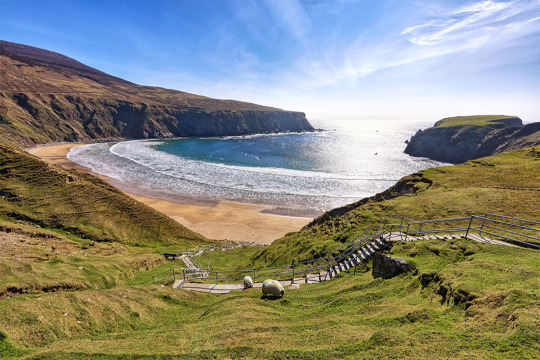
View On WordPress
#irelandinspires#irishhistory#OTD#wildatlanticway#5 April#An Trá Bhán#Co. Donegal#Gareth Wray Photography#garethwray.com#Guinness#Harp#History#History of Ireland#Ireland#Irish Civil War#Irish History#Irish War of Independence#Malin Beg#Silver Strand#Today in Irish History
8 notes
·
View notes
Text
SAINT OF THE DAY (June 9)
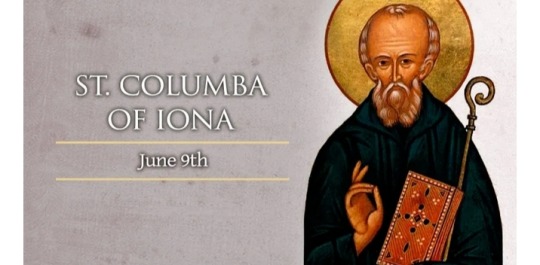
On June 9, the Catholic Church commemorates the sixth-century Irish monk and missionary Saint Columba of Iona, also known as St. Columcille.
One of Ireland's three patron saints, together with Saint Patrick and Saint Brigid, he is also sometimes called the “Apostle of the Picts” for his evangelization of Scotland.
He should not be confused with St. Columbanus (or Columban), a different Irish monk and missionary who lived slightly later and ended up in Italy.
Columba was born during 521, descended from royalty through his father. He was taught and mentored by the priest who baptized him and later attended a monastic school founded by Saint Finnian of Moville.
His own life as a monk began at the school, where he was also ordained a deacon.
The deacon went on to spend time in a different monastery and school run by another Finnian, Saint Finnian of Clonard.
Columba became a priest during this period, and along with eleven others from this same institution, he would become known as one of the “Twelve Apostles of Ireland.”
Columba also studied with Saint Mobhi of Glasnevin, before a disease epidemic forced him to return to his ancestral homeland of Ulster during 544.
He spent the next 15 years traveling, preaching, and founding monasteries.
It is not clear why, in 563, Columba left Ireland. By some accounts, he was simply going to preach the word of God.
Others claim that he had become involved in a battle between warring tribes, before repenting and taking on foreign missionary work as a penance.
On the island of Iona, located on Scotland’s northwest coast, Columba and his group of companions built simple monastic quarters and a church for themselves.
The priest-monk’s first missionary work was in the region of Dalriada, whose Celtic Christian inhabitants were lacking solid religious instruction.
His next effort was to convert the Picts of northern Scotland, a task that would take up most of the rest of his life.
He began by gaining entrance to the castle of King Brude, where the locked gates are said to have miraculously opened when the sign of the Cross was made.
The king welcomed the missionaries, believed the Gospel, and was baptized.
Columba’s evangelization of northern Scotland continued over the next three decades.
He and his companions met with some resistance from the native pagan Druids, but on the whole, they found remarkable success in spreading the Catholic faith and building up a network of churches and monasteries.
The island monastery at Iona remained his home base. It drew pilgrims looking to benefit from the priest-monk’s wisdom and his prayers.
He remained in touch with the Irish Church, making many trips back until he became too weak to travel.
Even in old age, Columba maintained an intense routine of prayer, fasting, and study.
After giving a final blessing to his monastery on 8 June 597, he died sometime in the early hours of the following day.
#Saint of the Day#Saint Columba of Iona#St. Columcille#Apostle of the Picts#Twelve Apostles of Ireland
6 notes
·
View notes
Text

Saint Brendan the Navigator
484 - 577
Feast Day: May 16
Patronage: boatmen, sailors, travelers, whales
St. Brendan the Navigator, an Irish saint, lived from 484 to 577. He was one of the Twelve Apostles of Ireland. He is most known for his legendary travels, especially to the “Isle of the Blessed”, also known as Saint Brendan’s Island. He is said to have encountered a sea monster and to have celebrated Easter Mass on the back of a giant whale!
Prints, plaques & holy cards available for purchase here: (website)
39 notes
·
View notes
Photo
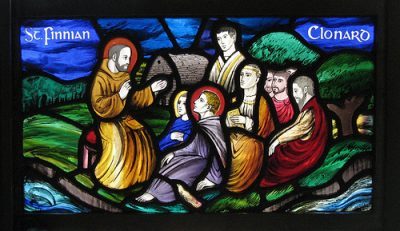
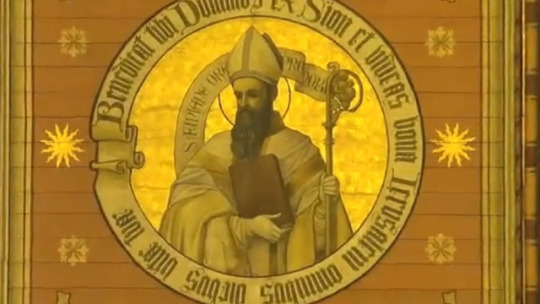



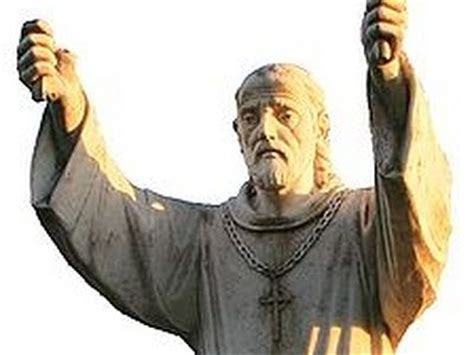
Saint Finnian of Clonard ('Cluain Eraird') – also Finian, Fionán or Fionnán in Irish; or Vennianus and Vinniaus in its Latinised form (470–549) – was one of the early Irish monastic saints, who founded Clonard Abbey in modern-day County Meath. The Twelve Apostles of Ireland studied under him. Saint Finnian of Clonard (along with Saint Enda of Aran) is considered one of the fathers of Irish monasticism.[
#saint#catholic#ireland#st finnian#st finnian of clonard#eire#twelve apostles of ireland#clonard abbey#county meath
7 notes
·
View notes
Photo
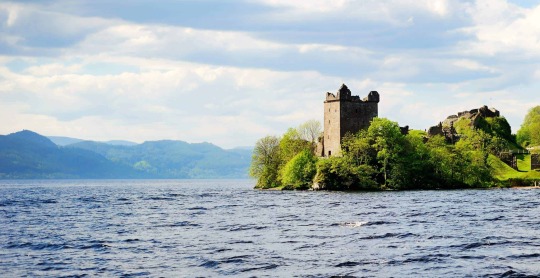
On this day, August 22, 565 St Columba reports seeing monster in Loch Ness. The first recorded sighting of the Loch Ness Monster.
Columba or Colmcille (7 December 521 – 9 June 597 AD) was an Irish abbot and missionary evangelist credited with spreading Christianity in what is today Scotland at the start of the Hiberno-Scottish mission. He founded the important abbey on Iona, which became a dominant religious and political institution in the region for centuries. He is the patron saint of Derry. He was highly regarded by both the Gaels of Dál Riata and the Picts, and is remembered today as a Catholic saint and one of the Twelve Apostles of Ireland. Columba studied under some of Ireland's most prominent church figures and founded several monasteries in the country. Around 563 AD he and his twelve companions crossed to Dunaverty near Southend, Argyll, in Kintyre before settling in Iona in Scotland, then part of the Ulster kingdom of Dál Riata, where they founded a new abbey as a base for spreading Celtic Christianity among the pagan Northern Pictish kingdoms. He remained active in Irish politics, though he spent most of the remainder of his life in Scotland. Three surviving early medieval Latin hymns may be attributed to him.
As for the “monster”, in the 1960s several British universities launched sonar expeditions to the lake. Nothing conclusive was found, but in each expedition the sonar operators detected some type of large, moving underwater objects. In 1975, another expedition combined sonar and underwater photography in Loch Ness. A photo resulted that, after enhancement, appeared to show what vaguely resembled the giant flipper of an aquatic animal.Further sonar expeditions in the 1980s and 1990s resulted in more inconclusive readings.
62 notes
·
View notes